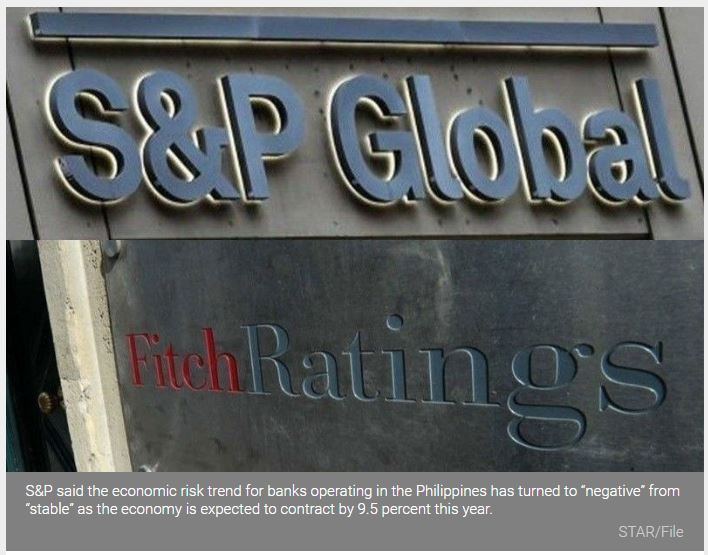Credit raters flag risks on Philippine banks
MANILA, Philippines — S&P Global Ratings and Fitch Ratings have raised the red flag over the potential impact of the COVID-19 pandemic on Philippine banks as a deeper economic recession could impair the industry’s asset quality, capitalization and profitability.
S&P said the economic risk trend for banks operating in the Philippines has turned to “negative” from “stable” as the economy is expected to contract by 9.5 percent this year.
“We believe the risk of credit losses soaring for Philippine banks is higher than we expected, given challenging economic conditions,” S&P said.
S&P also said the strict lockdown measures in major metropolitan areas, including Metro Manila, together with lingering household caution amid high COVID-19 infection rates and limited fiscal policy support, are suppressing consumer spending and resulting in widespread job losses.
The Philippines slipped into recession with a record GDP contraction of 16.5 percent in the second quarter from 0.7 percent in the first quarter.
“In our opinion, weak economic activity and tough employment conditions will affect the Philippine banking sector’s asset quality, earnings, and capitalization over the next two years,” S&P said.
S&P said the credit costs or the ratio of provision for bad loans may stay elevated at 1.5 to two percent in 2020 and 2021, while non performing assets may rise to 5.5 to 7.5 percent from 4.6 percent in end-August.
“The economic recession is likely to impair the debt-servicing ability of consumers, small businesses, and leveraged companies. We believe large conglomerates are better placed to weather the storm on the back of their strong business positions and good access to liquidity,” S&P said.
However, S&P said risks are rising and the performance of conglomerates would depend on economic recovery and stabilization of credit conditions.
“We see at least a one-in-three chance that economic risks facing the Philippine banking industry could increase over the next six to 24 months. We could lower our economic risk assessment for the banking sector if the recession is longer and deeper than our forecast,” S&P said.
As a result, S&P said the banking sector’s credit costs could stay above 2.5 percent over the next 12 to 24 months. Furthermore, the cumulative 175-basis points rate cuts by the Bangko Sentral ng Pilipinas (BSP) would affect margins, weighing down on earnings over the next 18 months.
“Banks’ recovery to pre-COVID-19 levels will likely stretch beyond 2022, noting their fairly strong performance prior to the crisis,” S&P said.
S&P downgraded its rating outlooks for Bank of the Philippine Islands and Security Bank Corp. to negative from stable.
For its part, Fitch said the weak domestic consumption and credit impairment are turning Philippine banks’ operating environment more challenging.
“Revenue tailwinds from aggressive monetary easing are also likely to dissipate by the second half and we see further asset-quality deterioration in 2021 after the debt moratorium lapses,” Fitch said.
Fitch pointed out credit costs are likely to remain elevated in 2021 even after declining from 2020’s unusually high levels, exerting continued pressure on earnings and profitability.
“Earnings will weaken as credit provisions spike, but the major banks have front-loaded such allowances in 2020 – a potential indication of a modest retracement in profitability in 2021 that should keep the banks’ common equity tier-1 ratios stable under our base case,” Fitch said.
Fitch affirmed the credit ratings of BDO Unibank, BPI, Metropolitan Bank & Trust Company and Philippine National Bank on the back of stable outlook. However, it retained the negative outlook for China Bank as its viability ratings remain under pressure amid the steep economic downturn.
Source: https://www.philstar.com/business/2020/10/14/2049330/credit-raters-flag-risks-philippine-banks


 English
English




